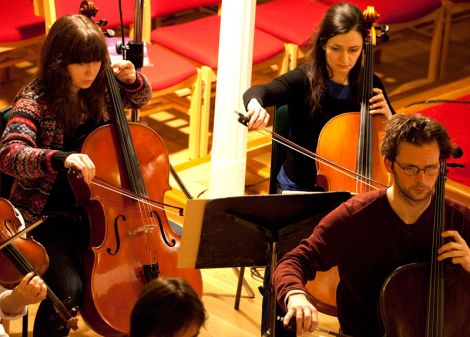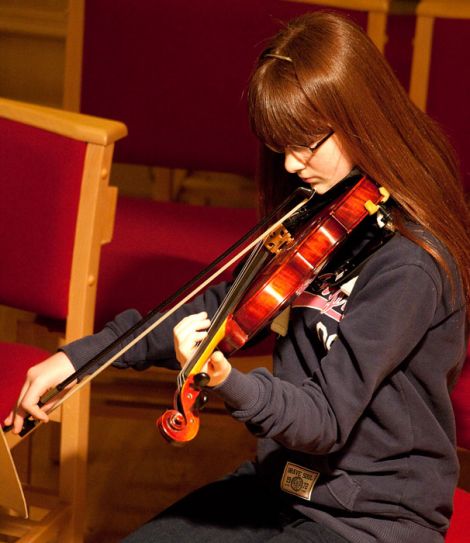Reviews / Review: The Big Kirk Chamber Concert
An immaculate, large white articulated truck is not the vehicle I usually see parked outside Da Muckle Kirk. Mind you it’s not a common occurrence for a full symphony orchestra to grace the shores of these peripheral isles.
I can barely imagine the logistics: how long does it take to organize such a 5 day visit, of so many people and instruments, and one so inclusive as to involve the outermost Shetland islands, care and leisure centres, schools, halls, a hotel, airport, and St. Columba itself?
Then there’s the dedication and sheer hard work of the members of the Royal Scottish National Symphony Orchestra; for example, flying on to Foula shortly after arriving from the Scottish mainland, all the rehearsing, playing, and interaction with the community and local musicians. An exhaustive and I dare say exhausting, not to mention expensive, five day schedule.
The concert on Saturday night featured a wide variety of chamber music for string orchestra, stretching from the eighteenth century to the twentieth. The emphasis, James Clark, the director, told us in his introduction, was on melody. There was as well, however, a wide variety of styles and cultures to be heard…
The evening began with Béla Bartók’s Rumanian Folk Dances, which was composed in 1915. These seven dances are based on music he heard in Transylvania, and in some of them oriental influences can be heard. Originally written for piano, it was supposed to last 4 minutes and 3 seconds; this lasted 7 minutes, however, according to the programme. Perhaps transcription to strings necessarily lessens the tempo. Or maybe our British sensibilities can’t quite cope with such a furious interpretation.
Giacomo Puccini’s Crisantemi (chrysanthemums are associated with death in much of Europe) was a complete contrast, a stately elegiac lament, with all the emotional depth we are familiar with from his operas. It was composed to commemorate his friend, the Duke of Savoy, who had also been once King of Spain. (Royalty knows no bounds.)
Become a member of Shetland News
The highlight of the evening followed next: Wolfgang Amadeus Mozart’s Violin Concerto No. 1, written when the prodigy was just 17 – arranged with horns and oboes, which gave more depth to the score. James Clark, who was the solo violinist, said it was “fiendishly difficult”.
In this part of the concert I was in the gallery and couldn’t see him. Which made me wonder: “How does he do that?!” He seemed to be wresting – I almost wrote “wristing” – almost impossible sounds out of the instrument, particularly in the final solos of each movement (Allegro moderato, Adagio, and Presto). This was indeed a virtuoso performance.
After the interval, Sir Edward Elgar’s Serenade for Strings evoked an English summer, with pastoral overtones. He first conducted this in a private performance by “The Worcester Ladies’ Orchestral Class”, which brings to mind late Victorian conventions or stereotypes. Was such pasture more tea on the lawn than nature in the raw? Although sumptuous (Elgar was an accomplished violinist), the emotional content of the music sounds almost restrained, compared to that of Bartók and Puccini.
Another big contrast followed with Johann Sebastian Bach’s Ricercar à 6, part of a Musical Offering to his patron, another regal figure, King Frederik II of Prussia. Thinking of the German author Hermann Hesse, it reminded me of a mathematically precise “glass bead game”: Six different lines of music, each played by different sections of the orchestra (Two of violin, two of viola, one of bass and cello, and one of cello). These were sometimes, though not always, played in fugal counterpoint simultaneously. Highly complex, and depending perhaps whether you were brought up as a child on a diet of Bach church music or not, either leading one to fall asleep or awake – the latter being one definition of great art.
Ludvig Holberg was a Bergen-born Norwegian: an historian, a dramatist, and a rationalist philosopher, altogether a man of the Age of Enlightenment. Edvard Grieg commemorated the 200th anniversary of his birth in 1884 with a suite “in olden style”, the Holberg Suite, which took us back in to an even earlier age. The piece, after an opening prelude, includes French dances of the classical era, a Sarabande, a Gavotte (with a lovely central section), concludes with a Rigaudon. Before that spirited Provencal dance is a haunting air (Andante religioso); the playing of cello and viola in this was particularly striking.
I mentioned earlier interaction with local musicians. On this occasion the liaison was beautifully demonstrated by inviting three young local music students to play in the orchestra. Violinists Hannah Adamson and Sophie Wishart, and cellist Martha Morton joined in the opening piece by Bartók, and again – as was promised by James Clark if we clapped loud enough – for an encore. The Pizzicato Polka by Johann Strauss II was a lightsome way to end the evening, with the First Violin Leader and Assistant Leader providing us with amusing deliberate mistakes.
The thunderous applause continued, and intensified as James Clark insisted that the three talented Shetlanders take a bow in turn: a fine example of the inclusivity that is the RSNO’s ethos, and symptomatic, I’m sure, of the whole long weekend.
James Mackenzie
Become a member of Shetland News
Shetland News is asking its readers to consider paying for membership to get additional perks:
- Removal of third-party ads;
- Bookmark posts to read later;
- Exclusive curated weekly newsletter;
- Hide membership messages;
- Comments open for discussion.
If you appreciate what we do and feel strongly about impartial local journalism, then please become a member of Shetland News by either making a single payment, or setting up a monthly, quarterly or yearly subscription.




























































